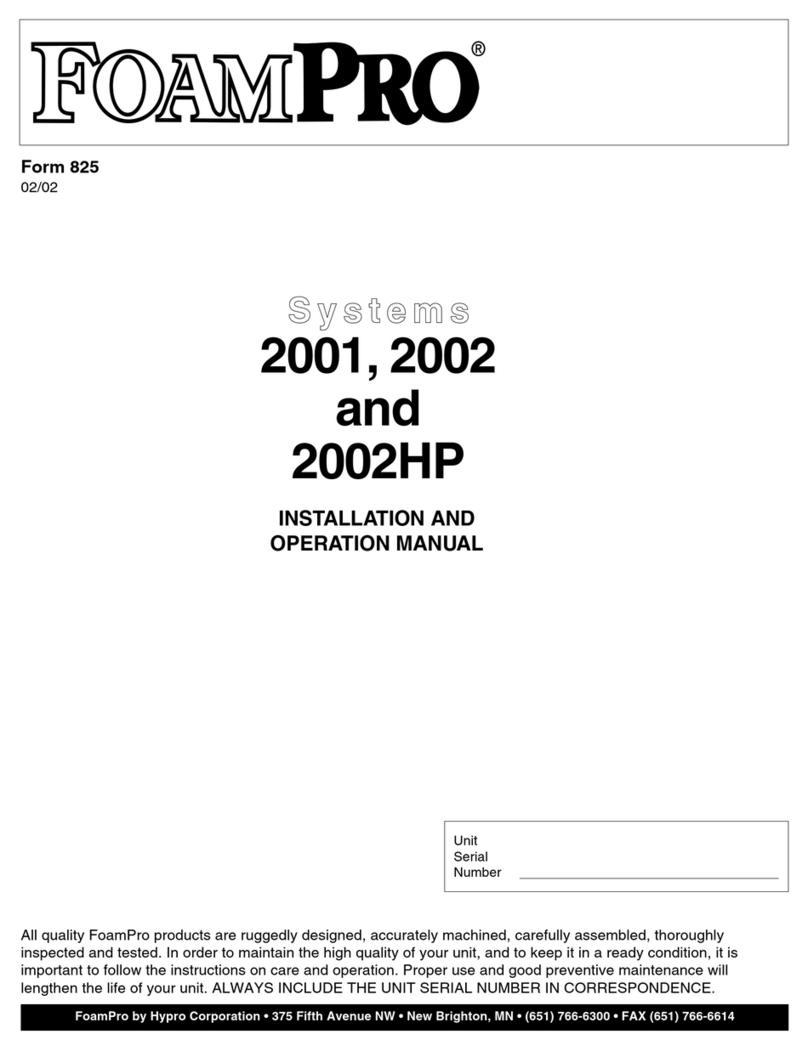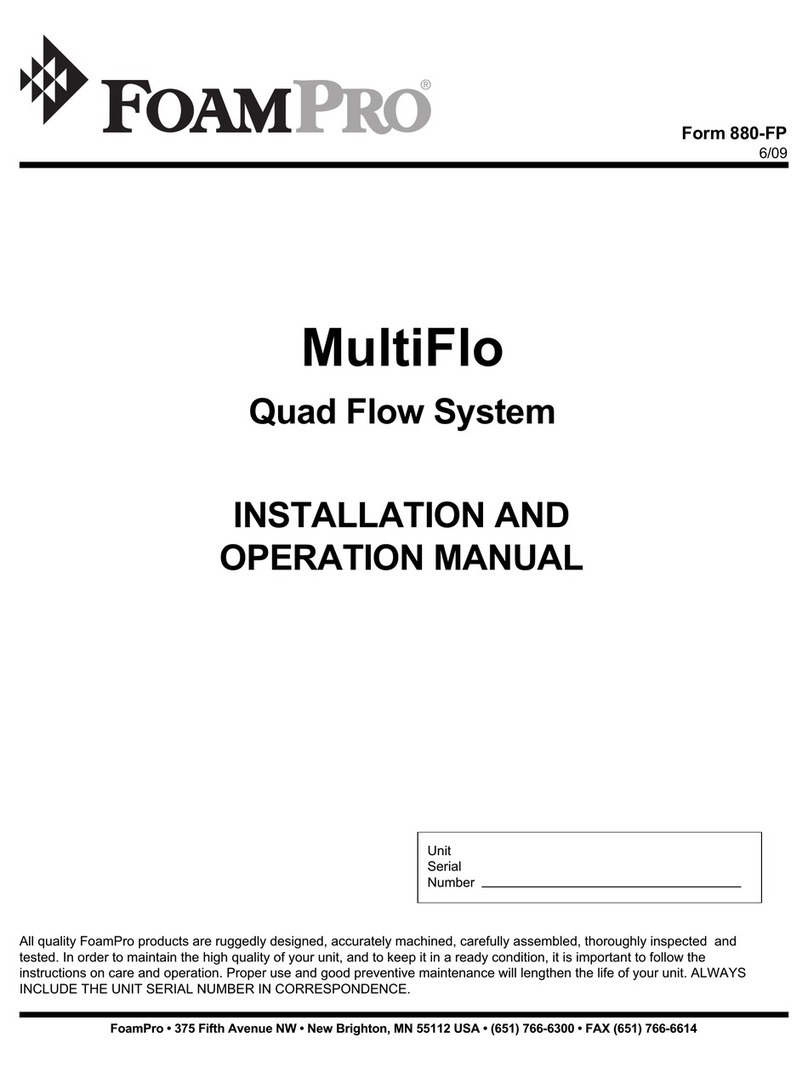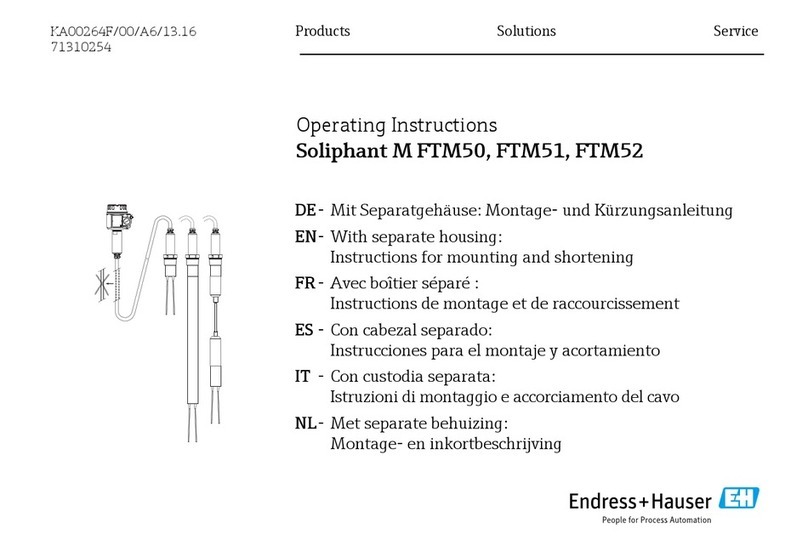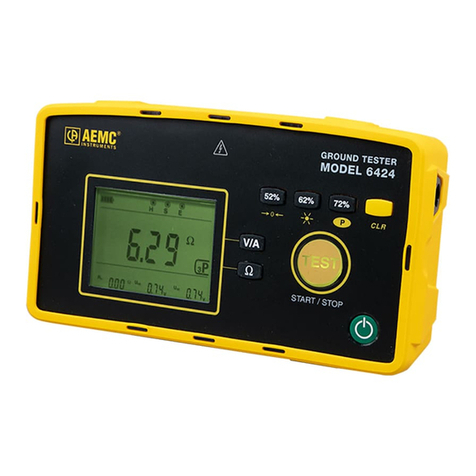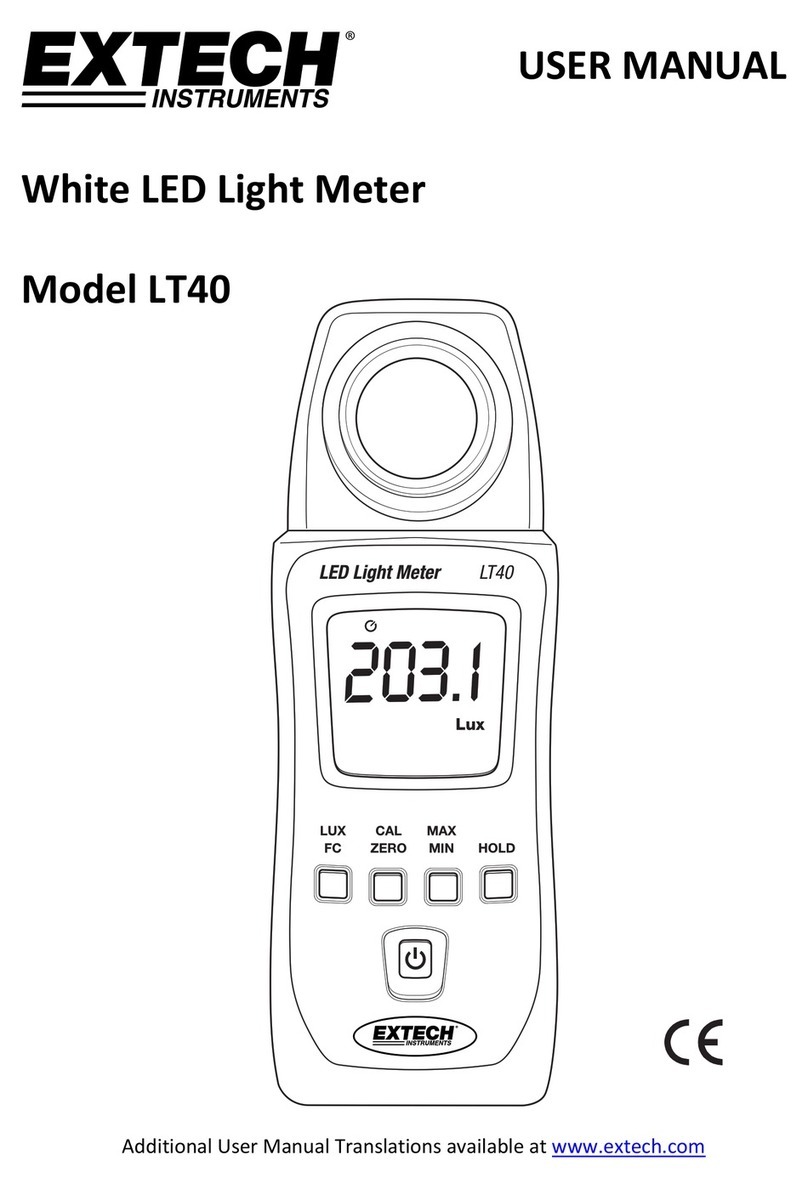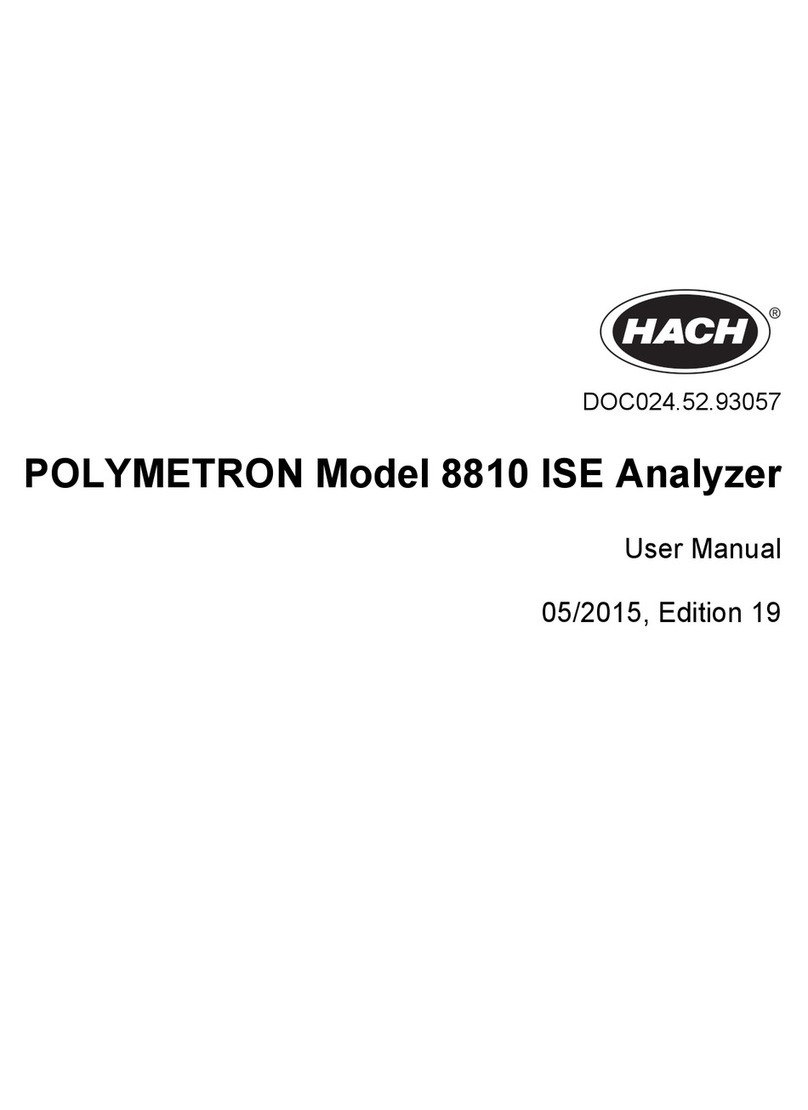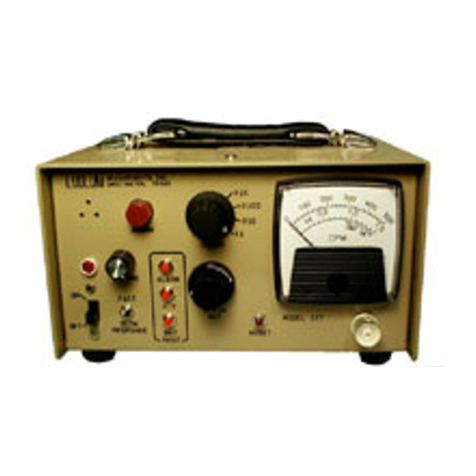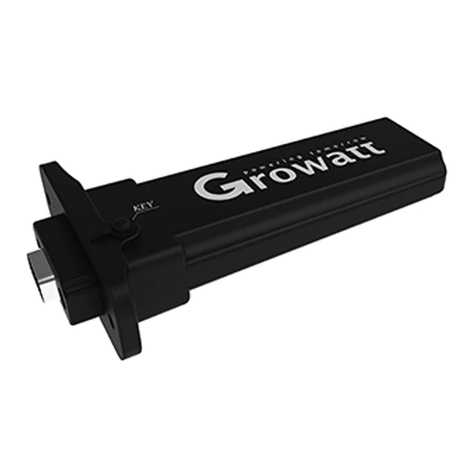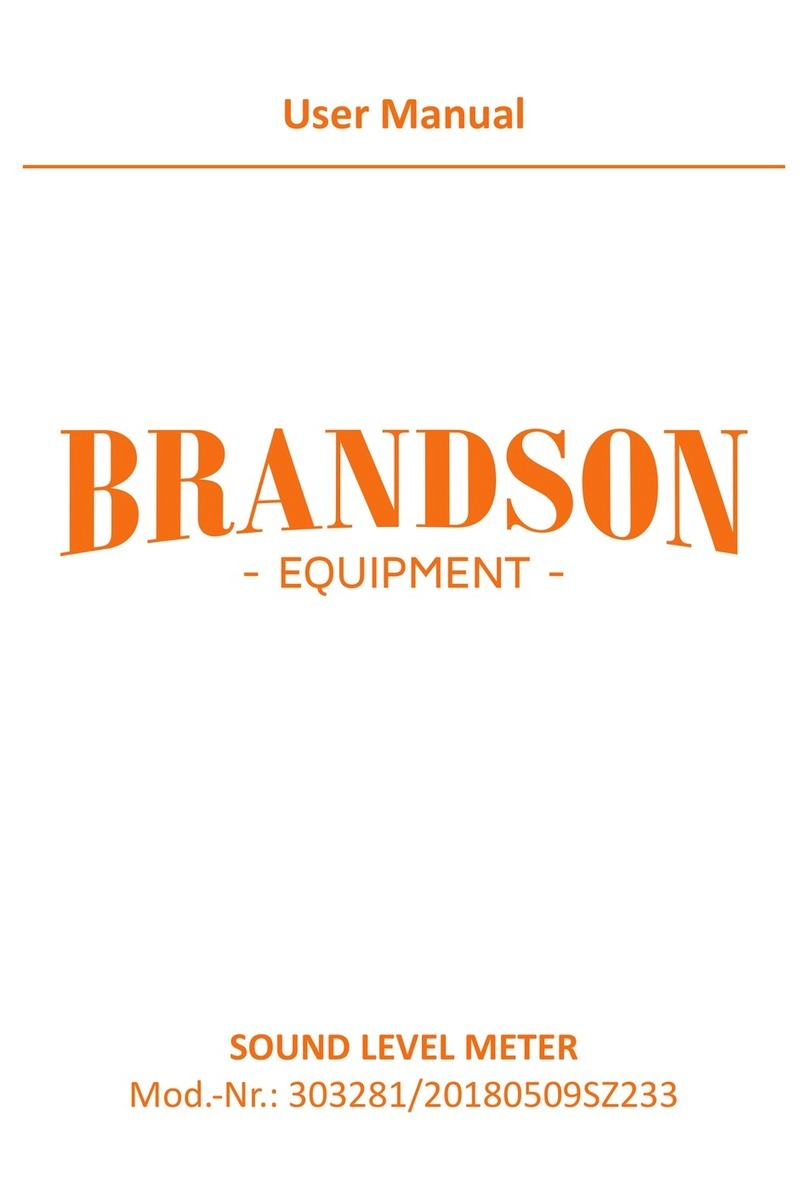FoamPRO 2001 Series User manual

1
INSTALLATION AND
OPERATION MANUAL
Form 829
6/16
All quality FoamPro products are ruggedly designed, accurately machined, carefully assembled, thoroughly inspected
and tested. In order to maintain the high quality of your unit, and to keep it in a ready condition, it is important to follow
the instructions on care and operation. Proper use and good preventive maintenance will lengthen the life of your unit.
ALWAYS INCLUDE THE UNIT SERIAL NUMBER IN CORRESPONDENCE.
Unit
Serial
Number
Systems 2001, 2002,
2002HP and 2024
FoamPro • 26 Southern Blvd. • Nesconset, NY 11767 USA • 800-533-9511 • FAX 816-892-3178

2
Installation and Operation ManualInstallation and Operation Manual
TABLE OF CONTENTS
Section Page
1 SAFETY...................................................................................................................... 3
2 A QUICK LOOK AT HOW THE SYSTEM WORKS.................................................... 4
3 SYSTEM COMPONENT DESCRIPTION................................................................... 5
4 INSTALLER SUPPLIED PARTS ................................................................................ 7
5 INSTALLATION PLANNING....................................................................................... 8
6 PLUMBING COMPONENT INSTALLATION ............................................................. 9
7 ELECTRICAL EQUIPMENT INSTALLATION........................................................... 14
8 MAKING SURE EVERYTHING IS WORKING RIGHT............................................. 20
9 CALIBRATION AND SETUP ................................................................................... 22
10 OPERATING INSTRUCTIONS................................................................................. 25
11 MAINTENANCE........................................................................................................ 31
12 TROUBLESHOOTING.............................................................................................. 32
13 PARTS IDENTIFICATION ........................................................................................ 36
14 INSTALLATION DRAWINGS ................................................................................... 39
15 WARRANTY ...............................................................................................Back Cover
NOTE TO SYSTEM INSTALLERS
IMPORTANT: Please provide a copy of the FoamPro manual to the end user of the equipment.
For additional FoamPro manuals, contact by FAX 816-892-3178, web site www.foampro.com,
or call 800-533-9511. Request Form No. 829.

3
Installation and Operation Manual
System 2000
Installation and Operation Manual
System 2000
1. Do not pump at pressures higher than the
maximum recommended pressure (400 psi [28
BAR]).
2. Do not permanently remove or alter any guarding
devices or attempt to operate the system when
these guards are temporarily removed.
3. Always disconnect the power source before
attempting to service any part of the pump. Note
this system contains a capacitor which will hold a
charge for a time after power is disconnected. Take
care to dissipate this charge by connecting a 12 or
24 volt test lamp from the pump base to the positive
main power terminal.
4. Release all pressure within the system before
servicing any of its components.
5. Drain all concentrate and water from the
discharge system before servicing any of its
component parts.
6. Check all hoses for weak or worn conditions after
each use. Ensure that all connections and fittings
are tight and secure.
7. From the foam pump outlet to the injector fitting,
use only pipe, hose, and fittings that are rated
at or above the maximum pressure (400 psi [28
BAR] minimum for 2001, 2002, 2024 and 600 psi
[41 BAR] for 2002HP) rating that the water pump
system operates.
8. Any electrical system has the potential to cause
sparks during service. Be sure to eliminate
explosive or hazardous environments during
service/repair.
9. CAUTION: Do not attempt to operate the
system at or above a temperature of 160°F
[71°C].
10. WARNING: Ensure that the electrical source
of power for the unit is a 12 or 24 volt, negative
ground, DC system. Power and ground lines
must come directly from the battery without any
connections to other high power devices, such as
primer pumps, hose reels, light bars, scene lighting,
etc. Refer to Section 7 for detailed information.
11. CAUTION: Be sure that the electrical
source of power for the 2000 series systems is
correct for the unit being installed. All systems
are negative-ground DC systems. The systems
require a minimum current rating of at least:
System Voltage Min. Amps
2001 12 VDC 41
2001 24 VDC 22
2002 12 VDC 60
2002 HP 12 VDC 60
2002 24 VDC 30
2002 HP 24 VDC 30
2024 24 VDC 60
12. CAUTION: Periodically inspect the pump and
the system components. Perform routine
preventive maintenance as required. Failure
to perform routine maintenance may damage
the pump. See the maintenance section of
this manual for recommended maintenance
procedures and intervals between maintenance
work.
13. CAUTION: Read and understand the “Operating
Instructions” section before attempting to
operate the unit.
14. CAUTION: Always disconnect the ground
straps and control cables from the Digital
Display Control Module or other FoamPro
equipment before electric arc welding at any
point on the apparatus. Failure to do so will
result in a power surge through the unit that
could cause irreparable damage to the display
or other system components.
15. CAUTION: The cables shipped with each
FoamPro unit are tested at the factory.
Improper handling and forcing connections can
damage these cables which could result in other
system damage.
1 Safety Before attempting to install a FoamPro System 2001/2002/2024,
read all of the following safety precautions and follow carefully.

4
Installation and Operation ManualInstallation and Operation Manual
The FoamPro 2000 series systems are electric motor-
driven, flow-based proportioning systems that measure
water flow and then inject the proportional amount of
foam concentrate to maintain the preset percentage.
The basic FoamPro 2000 series systems are shown
in Figure 1. The systems will accurately deliver from
0.1% to 10.0% foam concentrate to the foam injector
fitting. The flowmeter measures the water flow and
sends a signal to the Digital Display Control Module.
Another sensing device monitors the foam pump output.
Constant comparison of these two information signals
by the controller ensures maintenance of the desired
proportion of foam concentrate at all times based on
the water flow rate, independent of any variations in
fire pump intake or discharge pressures. As water flow
increases or decreases, the foam concentrate rate of
injection is increased or decreased automatically to
correspond to the water flow.
Foam concentrate is injected directly into the water
stream on the discharge side of the water pump. It is
then fed as foam solution by the main fire pump into a
standard fog nozzle, an air aspirated nozzle, or CAFS
equipment.
Figure 1. FoamPro System Layout
Since foam is injected on the discharge side of the fire
pump and check valves are to be used at installation,
contamination of the booster tank, fire pump and relief
valve with foam concentrate is eliminated.
Order optional system components listed in Section 3 to
accommodate system design and requirements.
2 A Quick Look at How the System Works
Single Discharge Coverage
Multiple Discharge Coverage with Manifold
Water Tank
Calibrate/Inject Valve
Water Pump Check Valve/Foam Injection Port
Foam Pump
and Motor
Foam Tank
Foam Tank
Shut-Off
Valve
Digital Display
Control Module
Line Strainer
Flowmeter
FoamPro 2000 series systems will pump Class A
and Class B Aqueous Film Forming Foam (AFFF) to
capacity. Many brands of Alcohol-Resistant Aqueous
Film Forming Foam (AR-AFFF) exhibit higher
viscosity characteristics due to chemical composition
and polymers. As viscosity increases, diminished
flow may affect pump performance. Because of
numerous variables; including pump design, foam cell
configuration, inlet piping/components and system
layout; please contact FoamPro at 800-533-9511 for
application-specific recommendations when foam
viscosities of 2000 cps (Brookfield #3 spindle @ 30 rpm)
or higher are used.

5
Installation and Operation Manual
System 2000
Installation and Operation Manual
System 2000
12
4
STANDARD FOAMPRO 2000 SYSTEM EQUIPMENT
The following components are packaged with the
FoamPro 2000 series:
1. Digital Display Control Module
2. Molded Cables
3. Foam Pump Assembly
4. Instruction Plate
5. Tank Low-Level Sensor (One required.
Not packaged with the unit. Order separately.)
6. Calibrate/Inject Valve with Bushing (Attached to the
pump outlet connection.)
7. Inlet Line Strainer with Nipple
8. FoamPro Paddlewheel Flowmeter or Manifold
(The flowmeter is a required component and must
be ordered separately. When ordering the 2000
series, specify the flowmeter size based on end
use requirements. The flowmeters are available
with 1-1/2 NPT x 1” Bore, 1-1/2, 2, 2-1/2, 3 and
4-inch NPT threads; or manifolds with Victaulic-
grooved ends in 1-1/2, 2, 2-1/2, 3 and 4-inch
pipe sizes. (Part numbers and flow ranges for the
various flowmeters can be found on Page 39.)
9. 1/2 Inch NPT Foam Injection Check Valve. This
NFPA required check valve prevents water back
flowing into foam systems.
6
3
9
5
Vertical Mount
(P/N 2510-0028)
Side Mount
(P/N 2510-0032)
7
3 System Component Description
8

6
Installation and Operation ManualInstallation and Operation Manual
SYSTEM ACCESSORIES AVAILABLE
FoamPro MultiFlo Interface
Combines 2 to 4 flowmeters
for single point systems
System Placard Solid State Contactor
P/N 2510-0043
Nesconset, NY 11767 US
A
Main Waterway Check Valve with Drain Port
Available in stainless steel or nickel plated steel,
NPT threaded ends with injection and drain ports
System
Specification Placards
Remote Start/Stop
Polypropylene Foam Tank(s)
8, 12 or 20 gallon capacity
Foam Manifold
All stainless steel with main waterway
check valve, water flowmeter, injection
port, and drain port. Victaulic grooved ends
For more information on these accessories, please see publications 856 and PL-21.
Manual Concentrate
Management System
Manual control for Dual Tank
Systems with interface
to controller
Electronic Concentrate
Management System
Electronic control for Dual Tank Systems
with interface to controller
Electronic Concentrate Management System
Electronic control of single or dual tank onboard
systems and an off-board pickup.
2002 Series and larger only
Main Waterway Check Valve
All stainless steel with Victaulic
ends and injection and drain ports
NFPA Calibration and Test Kit
For use with 1600 thru 3012 systems
Dual Injection Management System
Provides capability for switching between
two injection points
CAFS Power-Link
Interfaces FoamPro system with CAF system Single Tank Flush Kits
Both Internal and External flushing kits

7
Installation and Operation Manual
System 2000
Installation and Operation Manual
System 2000
FOAM CONCENTRATE SUCTION LINE
Fittings and hoses from the foam tank to the inlet of the
foam pump must be used. For 2001 & 2002 systems, use
3/4-inch (19mm) minimum inside diameter or larger hose,
dependent on the viscosity of the foam concentrate. For the
2024 system, use 1-inch (25mm) minimum inside diameter
or larger hose, dependent on the viscosity of the foam
concentrate. Use components that are rated for 23 in [584.2
mm] Hg vacuum and 50 psi [3 BAR[ pressure or greater. The
components must be compatible with all foam concentrates
to be used. Fittings used must be made of brass, 300 series
stainless steel or other corrosion resistant material. Before
selection of hose fittings, check for compatibility with foam
concentrates to be used. The use of clear suction hose is
required by NFPA to allow viewing foam priming operations.
The foam pump must be positioned to allow gravity feed from
the foam tank(s).
NOTE: When using a Dual-Tank System, intake
plumbing will be different. Refer to Concentrate
Management System Manual (Ref. Form 828 or 887) for
foam pump inlet plumbing installation.
FOAM CONCENTRATE DISCHARGE LINE
Fittings and hoses from the discharge of the foam pump to
the injector fitting must be supplied by the installer. Hoses
and fittings of 1/2-inch [13 mm] minimum INSIDE diameter
rated at 400 psi [28 BAR] minimum working pressure for
the 2001, 2002 & 2024; 600 psi [41 BAR] for the 2002HP or
maximum discharge pressure of the fire pump, whichever
is greater, must be supplied by the installer. Fittings and
hoses must be compatible with all foam concentrates to
be used. Use fittings of brass, 300 series stainless steel or
other corrosion resistant material compatible with all foam
concentrates to be used.
CHECK VALVES
NFPA requires installation of a check valve in the foam
concentrate injection line. To prevent foam concentrate
flow from the tank due to static head pressure, the foam
concentrate check valve shall have a 11 to 13 psi [0.8 to 0.9
BAR] cracking pressure and shall be capable of withstanding
the pressures that will be generated in the foam injection line.
A check valve is also required in all water piping locations
where foam concentrate could drain back into pumps or
other components of the fire apparatus. As a minimum, one
check valve must be installed where the foam solution water
piping connects to the fire pump discharge. (FoamPro main
waterway check valve is recommended.)
Multiple drains that allow individual drain lines to
communicate may allow foam to short circuit past the
check valves; avoid this possibility. FoamPro recommends
separate drain valve(s) for the discharge piping.
FOAM CONCENTRATE TANK(S)
Foam concentrate tank(s) must be supplied to suit the
capacity required for the apparatus application. The tank(s)
should meet NFPA minimum standards for the design
capacity, including filler size, venting and drain facility. For
example, to meet NFPA requirements using 1% AFFF foam
concentrate, a 40 gallon foam tank is required.
ELECTRICAL REQUIREMENTS
Electrical wiring must be supplied from the main apparatus
electrical system to the foam pump base system. Power
must be supplied directly from the apparatus battery without
any connections to other high power devices, such as primer
pumps, hose reels, auxiliary starters, light bars, etc. with its
own disconnect switch, or a switch or contactor actuated
by the battery disconnect switch, PTO or other device. Use
proper wire size to be able to supply the foam system with
the proper voltage and amperage required. The minimum
service is as follows:
2001 12VDC requires 41 amps
2002 or 2002HP 12VDC requires 60 amps
2001 24VDC requires 22 amps
2002 or 2002HP 24VDC requires 30 amps
2024 24VDC required 60 amps
Braided flat ground straps are required for ground
connections. The flat straps limit the RFI/EMI interference
encountered with radios, computers or other sensitive
electronic equipment.
CAUTION: Always disconnect the ground straps and
control cables from the Digital Display Control Module or
other FoamPro equipment before electric arc welding at
any point on the apparatus. Failure to do so will result
in a power surge through the unit that could cause
irreparable damage to the display.
The FoamPro 2000 series systems are provided with the major components and accessories required for
installation. Due to differences in chassis and apparatus configurations, the installer must provide pipe, hoses,
tubing, wire and fittings to satisfy installation requirements. The following paragraphs list the specifications for
selection of these components. Before beginning system installation, read this section thoroughly to make sure the
proper components are selected. For detailed system installation instructions, refer to Sections 5, 6 and 7.
4 Installer Supplied Parts

8
Installation and Operation ManualInstallation and Operation Manual
Because of the potential differences in apparatus
plumbing and foam system configuration, it is not
practical to depict exactly how each FoamPro unit can
best be installed onto a particular apparatus. Figure
2 shows the relative location of the FoamPro system
components. Most of the information contained in the
following sections, however, will apply to any situation.
It is recommended that you read the following
sections thoroughly before beginning installation of
the FoamPro system. It is also recommended that
you spend time planning and designing where and
how you intend to install this unit in the apparatus
before beginning the actual installation.
Determine the locations of the components to
be installed such as; foam tank(s), foam pump and
flowmeters. Try to place components in locations that
require the least amount of hoses and fittings.
Locate the foam pump unit in an area that is protected from
road debris and excessive heat buildup. Since the power
switch and CAL/INJECT valve are located on this unit, the
foam pump unit should be installed in an accessible area
located in the vicinity of the operator's panel.
Figure 2. System Component Location
The foam pump unit should be located below the
discharge of the foam tank(s) to provide for gravity feed
to the foam pump. The 2002 and 2024 systems can
be positioned with a suction lift not to exceed 6 ft (1.8
meters) and may be positioned accordingly. Locate the
foam tank(s) where the refilling can be done with 5 gallon
(19 liter) containers and other methods suitable to the
end user. Most water tank manufacturers will build the
foam tank(s) into the booster tank. When specifying
integral foam tank(s), make provisions for installing the
low-level sensor as well as foam suction connections
and tank drainage.
Determine a location for the Digital Display Control
Module on the operator panel of the apparatus.
Consider the routing path for the control cables from the
Digital Display Control Module to the foam pump unit
and flowmeter(s). If necessary, order longer or shorter
cable assemblies to suit the location demands.
CAUTION: Never attempt to cut or lengthen the
molded cables.
5 Installation Planning
HYPRO
Flowmeter

9
Installation and Operation Manual
System 2000
Installation and Operation Manual
System 2000
The following diagram (Figure 3) provides recommended guidelines for the location of the system components
that handle water, foam concentrate and foam solution. Note that additional options such as dual tank
systems, multiple flowmeters, etc., are covered by individual manuals included with those systems; consider
potential interferences.
A. FOAM PUMP/MOTOR BASE ASSEMBLY
The foam pump/motor base assembly must be mounted
in a horizontal position (See Figure 5). The base of the
foam pump must be anchored to a surface or structure that
is rigid and of adequate strength to withstand the vibration
and stresses of apparatus operation. Figure 4 provides the
mounting dimensions for the FoamPro 2000 series foam
pump/motor base assembly. It is required to use flexible
hose when making the hose connections to the FoamPro
2000 series. DO NOT hard pipe the system.
Position the foam pump so the circuit breaker/on-off switch
is easily accessible. Also, consider access requirements
for checking and changing the oil in the crankcase of the
foam pump. Be sure the foam concentrate hoses can be
properly routed to the inlets and outlets on the foam pump.
Position the 2001 and 2002HP foam pump assembly
so that the foam pump inlet is gravity fed from the foam
tank(s). The 2002 and 2024 foam pump assemblies can
be mounted in a position with a gravity fed inlet or with a
maximum vertical lift of no more than 6 feet (1.8 meters).
Ensure in all cases that the suction line size is appropriate
and minimal in length. Keep the usage of elbows to a
minimum and refrain from coiling or looping flexible lines.
All connections must be air tight. The foam pump/motor
base assembly must be mounted in an area to avoid
excessive exhaust system heat buildup.
6 Plumbing Component Installation
Horizontal
Mounting
Vertical
Mounting
DO DON’T
Figure 5. Foam Pump Mounting Position
Figure 3. FoamPro 2000 Series System Piping
Foam Tank
Shut-Off Valve
(Elec. or Man.)
Foam
Pump
Relief
Valve
Line
Strainer
To Calibration Container
Cal/Inject
Valve
Check Valve
Check Valve/
Foam Injection Port
Water
Pump
Single Discharge Manifold Discharge
Flowmeter

10
Installation and Operation ManualInstallation and Operation Manual
Protect the hoses and wiring from chafing and abrasion
during operation of the foam system.
Protect the foam pump base unit from excessive road
spray and debris. Although the system is sealed and
designed to be resistant to the harsh environment of
fire fighting apparatus, a protected location with easy
operator access is the ideal installation location.
After the foam pump/motor base assembly is mounted,
remove the shipping plug in the oil fill hole on the foam
pump gear case and replace it with the vented oil
dipstick (see Figure 6). Check the oil level by removing
the vented dipstick; make sure the oil level is to the full
mark on the dipstick. Proper oil level is also indicated
when the oil is visible in 1/2 to 3/4 of the oil level
sightglass. Add Dextron ATF oil if required. Replace
the dipstick when the oil level is correct.
Figure 6. FoamPro 2000 Series
Foam Pump Oil Level Check
Figure 4. FoamPro 2001/2002 Mounting Dimensions
B. DISCHARGE RELIEF VALVE
The discharge relief valve is installed on the outlet port
of the foam concentrate pump. It is provided to protect
the foam pump from excessive pressures. The relief
valve is factory set at 400 psi [28 BAR] (600 psi [41
BAR] for 2002HP model).
Figure 4a. FoamPro 2024 Mounting Dimensions
11-3/8"
11-7/8"
13-3/8"
22-3/4"
13/32" Mounting
Holes (4)
13/16"
33-9/16"
6-1/16"
16-1/8"

11
Installation and Operation Manual
System 2000
Installation and Operation Manual
System 2000
C. CAL/INJECT VALVE
The CAL/INJECT valve is mounted on the discharge side
of the foam proportioner. This valve shall be accessible by
the pump operator during normal operations. The valve is
a 3-way directional valve that selects where the output of
the foam pump will go.
Check to make sure the valve is installed properly.
Look at the ports as you move the handle, the flow should
go from the center port to each of the other ports.
The hose and fittings from the INJECT port to the
foam injector fitting should have 1/2-inch [13 mm]
inside diameter and be rated at 400 psi [28 BAR] for
2001/2002/2024 models or 600 psi [41 BAR] for 2002HP
models minimum working pressure or maximum
discharge pressure of the fire pump.
The hose from the CAL/FLUSH port may have a lower
pressure rating since it is plumbed to the atmosphere
and will not receive high pressures. This hose is used for
calibrating the foam pump, pumping the concentrate into
a container to empty the tank or to assist in priming of the
foam pump. The hose from the CAL/FLUSH port must be
long enough to reach a container outside the truck. This
hose must be coiled for storage when not in use.
D. LINE STRAINER
The line strainer that is provided with the FoamPro unit
has 3/4-inch NPT female threaded ports for the 2001 &
2002 systems and 1-inch NPT female threaded ports for
the 2024 system; and is to be installed on the inlet port
side of the foam pump. The hose from the foam tank
should have adequate wall stiffness to withstand the
vacuum of the foam pump while it is operating (23 in.
[584 mm] Hg and 50 psi [3 BAR]).
NOTE: If a pressurized water flush from one of the
discharges is incorporated, the plumbing and line
strainer exposed to this pressure must be rated
at or above the operating pressure of all other
discharge plumbing components. (400 psi [28 BAR]
minimum) (600 psi [41 BAR] for 2002HP models).
E. FLOWMETER(S)
The FoamPro 2000 Series systems are designed to
accept flow reading signals from the FoamPro
paddlewheel style flowmeter.
Proper flowmeter sizing is critical to system accuracy.
Select a flowmeter size based on actual flows required,
not standard pipe sizes. Refer to the installation drawing
at the end of this manual (Page 39) for proper flowmeter
sizing.
The flowmeters require that the amount of turbulence in
the pipe being monitored is as low as possible. Excessive
turbulence produces unstable and inaccurate flow
readings. The following installation guidelines will help
attain the best readings and maintain accuracy of the
FoamPro system when using the FoamPro paddlewheel
flowmeter in a tee or in the FoamPro manifold.
a. A minimum 5 times the pipe diameter of straight run
pipe without any fittings is necessary upstream of the
flowmeter.
10 times is better — the longer the straight run, the
lower the turbulence. Here are some examples of
required straight run:
Pipe Recommended
Size Straight Run Pipe
1-1/2 in. [38 mm].......7-1/2 to 15 in. [191 to 381 mm]
2 in. [50 mm] .............10 to 20 in. [254 to 508 mm]
2-1/2 in. [64 mm].......12-1/2 to 25 in. [317 to 635 mm]
3 in. [76 mm] .............15 to 30 in. [381 to 762 mm]
4 in. [100 mm] ...........20 to 40 in. [511 to 1016 mm]
b. The downstream plumbing of the flowmeter is not as
critical; but again, straight runs without fittings help
maintain accurate flow readings.
c. Do not mount a flowmeter directly after an elbow or
valve. Valves create severe turbulence when they are
“gated-down”.
d. Try to mount the flowmeters in a position that is
accessible for routine inspection and maintenance.
Figure 7. Flowmeter Placement

12
Installation and Operation ManualInstallation and Operation Manual
FOAMPRO PADDLEWHEEL
FLOWMETERS
The FoamPro paddlewheel-style flowmeter fittings
are specially designed tees and manifolds that make
inspection and maintenance of the flow sensor easy.
The threads of the tees are NPT. In horizontal runs, the
tees should be mounted as close to upright as possible
within the range shown in Figure 8.
With the use of a MultiFlo interface, two to four
flowmeters may be monitored simultaneously. A single
injection point that will supply foam agent to all foam
discharge outlets is required.
F. INJECTOR FITTING (optional)
The brass injector fitting ensures foam concentrate
is injected into the center of the water flow for
better mixing. It is designed to fit into a 1 inch NPT
threaded connection on a pipe tee that is installed
in the discharge piping of the fire pump (See Figure
9). The inlet of the
fitting is 1/2 inch NPT
female thread and the
outer threads are 1 inch
NPT. The injector may
also be inserted into a
weld fitting with 1 inch
NPT female threads. It
MUST be mounted in a
place that is common
to all discharges which
require foam capability.
This fitting is not used
if using a FoamPro Main Waterway Check Valve. A
separate injection point is not possible for each
discharge. If multiple flowmeters are used, the injector
must be installed before the flowmeters at the inlet to
their common manifold (See Figure 10).
Most foam concentrates by nature mix with water
very quickly, so each discharge from a manifold will
receive equal concentrations if the manifold is properly
designed and installed.
G. CHECK VALVES
A 1/2 inch NPT check valve meets NFPA requirements
for a non-return device in the foam injection system.
To prevent foam concentrate flow from the foam
concentrate tank due to static head pressure, the foam
concentrate check valve shall have a 12 psi [0.6 BAR]
cracking pressure and shall be capable of withstanding
the pressures that will be generated in the foam
injection line. It is always a good idea to inject foam at
a horizontal or higher angle to allow water to drain away
from the check valve (See Figure 11). This will avoid
sediment deposits or the formation of an ice plug.
The check valve in the water way is required to keep
foam solution out of the main pump and allow pump
priming without drawing foam into the piping. See
Figure 12.
Figure 8. Flowmeter Position Range
Tee Shown without
Sensor Installed
85°
Max.
85°
Max.
Figure 9. Injector Fitting
Installation
Figure 10. Injector Fitting Placement for
Multiple Discharges
Injector
Fitting
(optional)
(optional)
Injector Above
Horizontal Plane
DO
DON'T
Injector Below
Horizontal Plane
Injector Above
Horizontal Plane
DO
Injector Below
Horizontal Plane
Figure 11. Foam Injector Position
DON’T

13
Installation and Operation Manual
System 2000
Installation and Operation Manual
System 2000
H. DRAIN LINES
On apparatus with multiple drain lines, the drains from
the foam solution discharge line should not be piped
into a multi drain system before the check valves. The
standard multi drain system from most manufacturers
will allow cross talk between the drain lines and the
apparatus water tank, resulting in contamination of the
water tank with foam. A separate drain system should
be provided for the foam solution piping to prevent
contamination of the water tank and fire pump.
I. FLUSHING SYSTEM
Depending on the corrosiveness of the foam
concentrates to be used, a flushing system may be
required in the foam concentrate injection system.
Generally, all Class B foam concentrates must be
flushed from the system after use. Most Class A foam
concentrates (per NFPA 1150) are less corrosive
Figure 12. Recommended Pump Installation
and therefore may not require flushing. Fig. 12-4 is a
recommended diagram for a flush circuit. When a dual
tank system is installed on the apparatus, provision for
flushing the foam concentrate injection system is built
into the dual tank selector system.
Minimum Length of Nipple
for 2-1/2" [158.75 mm] Pipe
is 12-1/2" [317.50 mm].
Refer to the Table on Page
11 for the recommended
Nipple lengths for different
pipe sizes.
Main Waterway
Check Valve
Drain Line
Check Valve
Injection Port
Drain Port
Flowmeter
Figure 12-4. Foam Concentrate Flushing System
Diagram
Flushing Foam Pumps
When returning the apparatus to ready condition after
foam operations, the FoamPro foam pumps should
be flushed. The following procedures can be used to
flush the foam pumps. Refer to Figure 12-4 and do the
following:
1. Energize apparatus and establish water flow
through foam solution discharge.
2. Close foam concentrate tank shut-off valve and
open flush water supply valve.
3. Energize FoamPro 2000 and allow electric motor
driven foam pump to run until discharge is clear.
4. Shut off FoamPro 2000 system by depressing the
FOAM button on the Digital Display Control Module.
Close flushing water supply valve.
5. Close foam solution discharge and shut down
apparatus.
6. Open foam concentrate tank shut-off valve.
7. Perform required maintenance checks on the
FoamPro 2000.

14
Installation and Operation ManualInstallation and Operation Manual
ELECTRICAL CONNECTIONS
Follow the system electrical diagram (Figures 13,14 and
30) for proper hookup of each of the electrical components.
Complete molded cable sets are provided with each
FoamPro system to make all the necessary connections.
The cables are color coded and “indexed” so they only go
in the correct receptacle and they can only go in one way.
DO NOT FORCE MISMATCHED CONNECTIONS. The
system can only perform when the electrical connections
are sound, so make sure each one is right.
SOME THINGS TO KEEP IN MIND
•DO NOT hook up the main power cables until all
connections are made to each of the electrical
components. The last connection should be the power
cable to the foam pump/motor base assembly.
• WARNING: This system contains a capacitor
on the input power. Connect the leads with the
battery off or disconnected. Current will flow even
with the circuit breaker off.
•DO NOT cut molded cables.
• Power must be supplied directly from the apparatus
battery without any connections to other high power
Figure 13. FoamPro 2002/2002HP/2024 Electrical Wiring Diagram
devices, such as primer pumps, hose reels, auxiliary
starters, light bars, et. with its own disconnect switch,
or a switch or contactor actuated by the battery
disconnect switch, PTO or other device.
•Provide at least the following amounts of electrical
power from the battery to the main power terminal:
2001 12 VDC requires 41 amps;
2002 or 2002HP 12 VDC requires 60 amps;
2001 24 VDC requires 22 amps;
2002 or 2002HP 24 VDC requires 30 amps;
2024 24VDC requires 60 amps.
Use proper wire size from the system terminal directly
to the battery as described on page 17.
•The S1xx-xxxx systems are designed for 12-volt,
negative-ground systems only. The S2xx-xxxx
systems are designed for 24-volt, negative-ground
systems only.
• Do not mount radio transmitter or transmitter cables in
direct or close contact with the FoamPro unit.
• Connect ground strap with 3/8” mounting hole to
chassis frame.
• Use care when installing molded cables. Count
pins or check color codes before connecting.
7 Electrical Equipment Installation
TO POSITIVE BATTERY CONNECTION,
BATTERY SWITCH RELAY,
OR CONTACTOR

15
Installation and Operation Manual
System 2000
Installation and Operation Manual
System 2000
Figure 14. FoamPro 2001 Electrical Wiring Diagram
Bent pins caused by improper hookup can
prevent proper operation even when cables are
reattached properly.
• Before connecting the molded cables, inspect the
yellow seal washer in the female connector. If the
seal washer is missing or damaged, water can
enter the connector and cause corrosion of the pins
and terminals that will cause system failure.
• CAUTION: The cables shipped with each
FoamPro unit are tested at the factory with
that unit. Improper handling and forcing
connections can damage these cables, which
could result in other system damage.
• CAUTION: Always disconnect the ground
straps and control cables from the Digital
Display Control Module or other FoamPro
equipment before electric arc welding at any
point on the apparatus. Failure to do so will
result in a power surge through the unit that
could cause irreparable damage to the display
or other system components.
A. DIGITAL DISPLAY/CONTROL MODULE
The Digital Display Control Module is designed to be
mounted in the operator panel of the apparatus. The
cutout that will be needed in the operator panel is a
3-7/8 inch [98 mm] diameter hole (the same as a 3-1/2
inch [89 mm] pressure gauge). The display is secured
with four #10 socket head screws in the four holes
in the face (See Page 38 for a mounting template).
The display requires 5 inches [127 mm] minimum
from the back of the operator panel to clear wires
and connectors. Make sure there is enough clearance
behind the operator’s panel for the cables.
Once the Digital Display Control Module is mounted,
connect the control cable (red coded cable end) from
the motor driver box terminal to the 5 pin connector
on the back of the Digital Display Control Module (See
Figure 15). A color-coded decal on the motor driver
box identifies each cable connection (See Figure 16).
TO POSITIVE BATTERY CONNECTION,
BATTERY SWITCH RELAY,
OR CONTACTOR

16
Installation and Operation ManualInstallation and Operation Manual
Figure 16. Motor Driver Box Connections
Figure 15. Digital Display Control Module Cable
Connections and Grounding
SPEED SENSOR
TANK SENSOR
CONTROLLER
CAPACITOR
DIODE
CIRCUIT BREAKER
ON
OFF
+
+
* Connections to be made
during installation.
*
*
NOTE: Make sure the panel where the Digital Display
Control Module is mounted has an adequate ground.
For stainless steel and vinyl-coated panels, a flat
ground strap must be attached from one of the four
screws holding the Digital Display Control Module
in place, to the frame of the fire truck to ensure
adequate grounding (See Figure 15).
B. FLOWMETER(s) CONNECTIONS
FOAMPRO FLOWMETER
If a single FoamPro paddlewheel-type flowmeter is
to be used, a molded cable that connects from the
flowmeter to the 3 pin connector on the Digital Display
Control Module is supplied.
MULTIFLO FLOWMETER INTERFACE
MODULES
See the instructions supplied with the MultiFlo interface
for installations requiring multiple Foampro flowmeters.
Figure 17 shows the interconnection of the flowmeters
with the Digital Display Control Module.
C. FOAM TANK CONNECTIONS
The foam tank low-level sensor must be mounted into the
bottom of the foam tank to monitor low foam concentrate
level. The switch has 1/8 inch NPT threads. Mount the
sensor in the bottom of the foam tank in an upright position.
Use suitable sealant to prevent concentrate leakage.
There must be space under the tank for the cable to be
routed to the pump base assembly (See Figure 18). Be
sure not to remove the float from the shaft on the sensor
assembly. If installed in the reverse position, “LO CON”
and “NO CON” will appear on the Digital Display Control
Module, and the system will automatically shut down after
two minutes, even if there is foam in the tank.
When the bottom of the foam tank is not accessible, the
low-tank level sensor float switch can be hung from a long
nipple attached to the top of the tank. The nipple should
be rigid enough to withstand the force of sloshing foam
when the vehicle is in motion. Make sure the low-tank
level sensor does not contact the side of the foam tank
when the vehicle is in motion (See Figure 18). Since wire
connections must be made inside the nipple, a 3/8 inch
NPT nipple with 3/8 by 1/8-inch NPT reducer at the lower
end is the minimum size recommended.
CAUTION: The foam tank low-level sensor must be
utilized to protect the foam pump from dry running.
Failure to do so will void the warranty.
Connect the sensor wires to the low-tank level sensor cable
(blue-coded cable ends). The low-tank level switch sensor
cable may be shortened or lengthened (use 18-22 AWG).
It has pigtails at one end and is not polarity sensitive.
Connect the other cable end to the motor driver box on the
foam pump/motor base assembly (see Figure 16).
Check low-tank level sensor operation after installation
using a powered test light. With no foam in the tank, the

17
Installation and Operation Manual
System 2000
Installation and Operation Manual
System 2000
light should be on. If this is not the case, remove the
clip from the end of the sensor. Remove the float and
reinstall 180° out of position. Reinstall clip.
A side-mount tank level sensor is available to be used if
both the top and bottom of the tank is not accessible (See
Figure 18). The side-mount tank level sensor has 1/2-inch
NPT threads and the center of the switch must be located
approximately 2 inches [51 mm] from the bottom of the
foam tank with the float positioned on top of the switch to
move up and down.
NOTE: When the side-mount tank level sensor
senses a low concentrate condition, the system will
operate for two minutes unless the foam concentrate
level is restored. If the foam concentrate level is not
restored, the system will shut down after two minutes.
When locating the side-mount low-tank level switch on
the foam tank, sufficient foam volume must be present
for two minutes of operation. This determination will
be made using the most frequent foam concentrate
injection rate and water flow.
The side-mount tank level sensor must be sealed with
a suitable sealant to prevent concentrate leakage. After
installation, check operation of the side-mount low-tank
sensor with a powered test light. With no foam in the tank,
the light should be on. If light does not come on, rotate the
side- mount low-tank sensor until the test light is on. The
float should be allowed to swing up and down freely.
D. DC MOTOR
Provide adequate electrical power (see the
listing on Page 15) from the battery. Use 8 AWG minimum
wire directly to the battery or battery switch. Long wire runs
may require 6 AWG wire for proper operation.
See recommended wire size table on page 18.
E. ELECTRICAL POWER SUPPLY
Electrical devices can be damaged, or operate
intermittently when powered by a weak or erratic power
supply. The FoamPro 2000 Series systems are not any
different – the better the power supply, the better the
system will perform. Following the instructions that follow
will ensure the FoamPro system will perform at its best.
Power and ground connections must come directly from
the battery to the connections shown in figures 13 and 14.
These connections must come directly from the battery
without any connections to other high power devices such
as primer pumps, hose reels, auxiliary starters, light bars,
etc., with its own disconnect switch, solid state contactor
or a switch or contactor actuated by the master disconnect
switch, PTO switch, or other device. Ensure the switching
device is rated for at least twice the maximum amperage of
the system being installed.
See the Electrical Power Supply Schematic and
Recommended System Fuze Size table on page 18.
CAUTION: Connecting other high power devices to the
power or ground supply with the FoamPro system will
cause component damage.
The system maximum amperage draw is listed as follows
and must be protected with a fuse or breaker of minimum
size listed in the main power line to the system and
provides enough power and protection for the display,
driver, motor, and associated components. If attaching
other FoamPro products to the supply line, the fuse or
breaker must be sized accordingly. It is also recommended
to install a fuse or breaker of at least 50% of the main fuse
or breaker value on the main ground line. All component
power and ground connections must be common for all
FoamPro components.
•Always connect the primary 12 or 24 VDC positive lead
for the system directly to the battery or power switch using
appropriate AWG wire that is chemical resistant and pro-
tected with a wire loom. Install the proper fuse or breaker
size in the line that supplies the main power to the system.
Figure 17. MultiFlo and Flowmeter Connections
Figure 18. Foam Tank Low-Level Sensor
Mounting Options

18
Installation and Operation Manual
Recommended System Fuse Sizes
System
Model
Operating
Voltage
Maximum System
Amp Draw
Minimum Fuse or
Breaker Size
2001 12 VDC
24 VDC
41
22
45
25
2002 &
2002HP
12 VDC
24 VDC
60
30
60
30
2024 24 VDC 60 60
Recommended Wire AWG
System
Model
System
Voltage
Max
Amps
10 ft. 15 ft. 20 ft. 25 ft. 30 ft.
2001 12 VDC
24 VDC
41
22
8
8
6
8
4
8
4
6
2
6
2002 &
2002HP
12 VDC
24 VDC
60
30
6
8
4
8
4
6
2
4
2
4
2024 24 VDC 60 6 4 4 2 2
•It is recommended to connect the ground lead for
the main system directly back to the battery using the
same AWG size as the main power line and it should
also be chemical resistant wire protected in a wire
loom. Installation of a fuse or breaker of at minimum of
50% of the main power breaker in line with the ground
to the system.
•Never connect the main power or ground leads to other
leads that are connected to high power components
such as primer pumps, hose reels, auxiliary starters, etc.
•Always make the connection to the primary power
supply the last step.
•Always ensure the connections are sound and tight to
avoid erratic or poor power and ground connections to
the components.
•Always make sure the Control Display and the Base
System are grounded to the chassis using at ground
straps to reduce potential RFI and EMI issues.
Master Disconnect Switch,
PTO Switch,
or Manual Switch
To Other Devices
Battery
Relay, or Solid
State Contactor
Appropriately Sized
Amp Fuse or Breaker
Common Power Connection
for other FoamPro Accessories
Common Ground Connection
for other FoamPro Accessories
Power Lead (+)
Ground Lead (-)
System Z
Bracket Assy
Controller
Electrical Power Supply Schematic

19
Installation and Operation Manual
System 2000
F. SOLID STATE CONTACTOR (SSC)
The usage of the optional solid state contactor (SSC)
is recommended to help protect the FoamPro system
from excessive voltage surges that can take place in
fire apparatus systems. The SSC also has a higher
life expectancy than mechanical relay options used for
master switch applications.
The SSC allows the operator to easily power the system
up and to shut it down with the use of a simple switch. The
following diagram depicts the installation of this accessory.
G. EMI/RFI SUPPRESSION
An EMI/RFI (Radio Frequency Interference)
suppression kit is included with each FoamPro
system. The clamp-on beads included in the kit, when
properly installed, along with proper grounding of
components will reduce the potential for radio frequency
interference. Additionally, make sure radio cables and
hardware are not located in the immediate area where
the FoamPro 2000 Series equipment is mounted.
Install clamp-on beads at the locations indicated in
Figure 19. Slide the beads as close as possible to
the connectors on the cable. Use a small amount GE
SILICONE II, electrical tape, wire tie or heat shrink
tubing to keep the beads from moving after installation.
FLOWMETER AND CABLES
Making round coils of extra control and flowmeter cables
in the pump compartment can act as an antenna. While
the flowmeter and control cables cannot be shortened,
various lengths of cable are available to minimize the
Figure 19. RFI/EMI Bead Installation
Figure 20. Extra Cable Storage
“extra” cable in the truck. (See the parts list in Section 13
for part numbers of different size control and flowmeter
cables.) When routing control and flowmeter cables,
avoid routing them next to antenna cables, radio power
lines and radio components. When there is extra cable,
double the cable back on itself and secure in a flat
bundle with plastic wire ties instead of making a round
coil (See Figure 20).
Nesconset, NY 11767 US
A
Engage Switch
Open - Off
Closed - On
Ground
Ground
+ Power
to
FoamPro
Unit
Solid State Contactor
2510-0043
Battery
Solid State Contactor Installation

20
Installation and Operation Manual
SYSTEM POWER CHECK
Turn the main power switch on the motor driver box
to ON and check the digital display readout — “FRC
or HYPRO” should appear for a few seconds while
the controller checks itself (See Figure 21); then, a
zero should appear on the digital readout. If no zero
appears, refer to the “TROUBLESHOOTING” section
for possible causes and solutions.
FOAM PUMP PRIMING CHECK
Turn the CAL/INJECT valve to the CALIBRATE or
FLUSH position. Provide a container to collect the
output that will be coming from the foam pump. Figure 21.
Digital Display Control Module
Electrical
• Tank level sensor is connected and the connections are sealed from moisture.
• Digital Display Control Module connectors are correct and tight.
• Cable connections at the motor driver box are correct and tight.
• Flowmeter cable(s) properly connected to the Digital Display Control Module or MultiFlo as required.
• All cables and wires are secured and protected by loom from damage during operation.
• RFI/EMI beads are installed; control and flowmeter cables are properly folded and secured; radio
antennas, power lines and equipment are away from the control and flowmeter cables.
• All components, Digital Display Control Module, Flowmeter Tee, Pump Base, etc., are properly
grounded with adequate size wire and bare metal connections.
• Adequate current capacity is available for the foam pump motor (see the listing on Page 14).
• Circuit breaker switch on the motor driver box is in the ON position.
Liquid
• Flowmeter is mounted with flow arrow in the correct direction for water flow.
• Check valves are properly mounted in water and foam concentrate lines.
• Strainer is properly mounted for the direction of concentrate flow in the foam tank to pump line.
• Foam tank to the foam pump valve is in place and open.
• Injector fitting lines are proper size and connections are tight.
• CAL/INJECT valve is properly mounted and oriented for direction of concentrate flow.
• The injector is in a common point to supply foam concentrate to all discharges specified to have
foam capability.
• Fill foam tank(s) with a sufficient quantity of foam concentrate or water to allow system calibration.
Minimum of 5 gallons required.
• Foam is properly primed.
FOAM PUMP
• Foam Pump gear case filled to proper level proper lubricant (see Maintenance section for information).
8 Making Sure Everything is Working Right
This manual suits for next models
3
Table of contents
Other FoamPRO Measuring Instrument manuals
Popular Measuring Instrument manuals by other brands

Kaman
Kaman KDM-8206 Reference manual
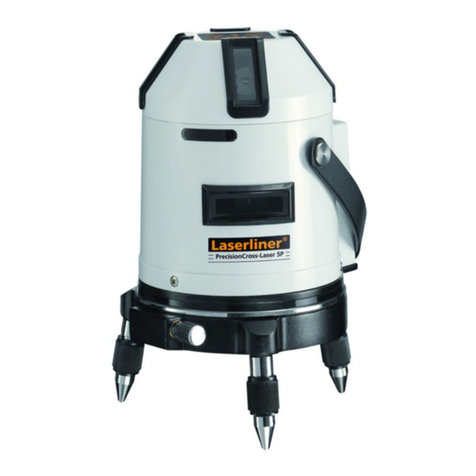
LaserLiner
LaserLiner PrecisionCross-Laser PCL 5P RXR operating instructions

WIKA
WIKA 2XX.34 Operating & installation instructions

PanelPilot
PanelPilot SGD 24-M-IP quick start guide
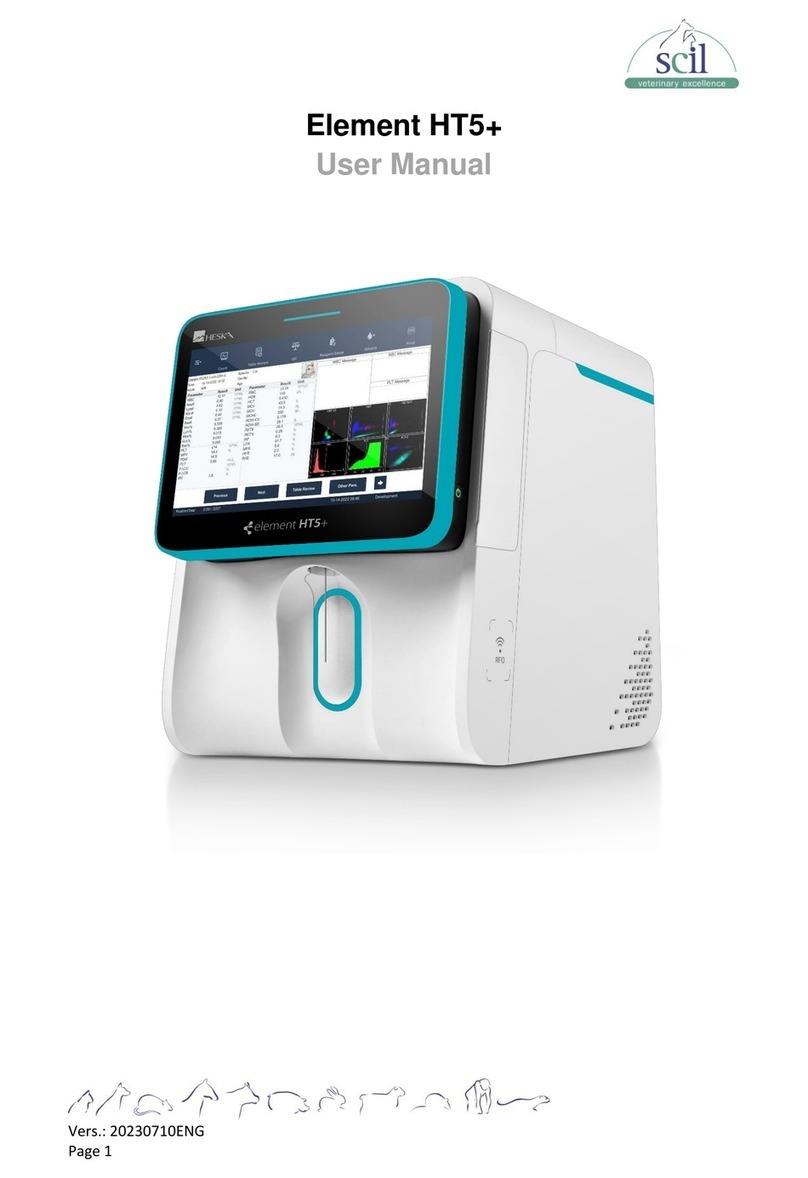
scil
scil Element HT5+ user manual
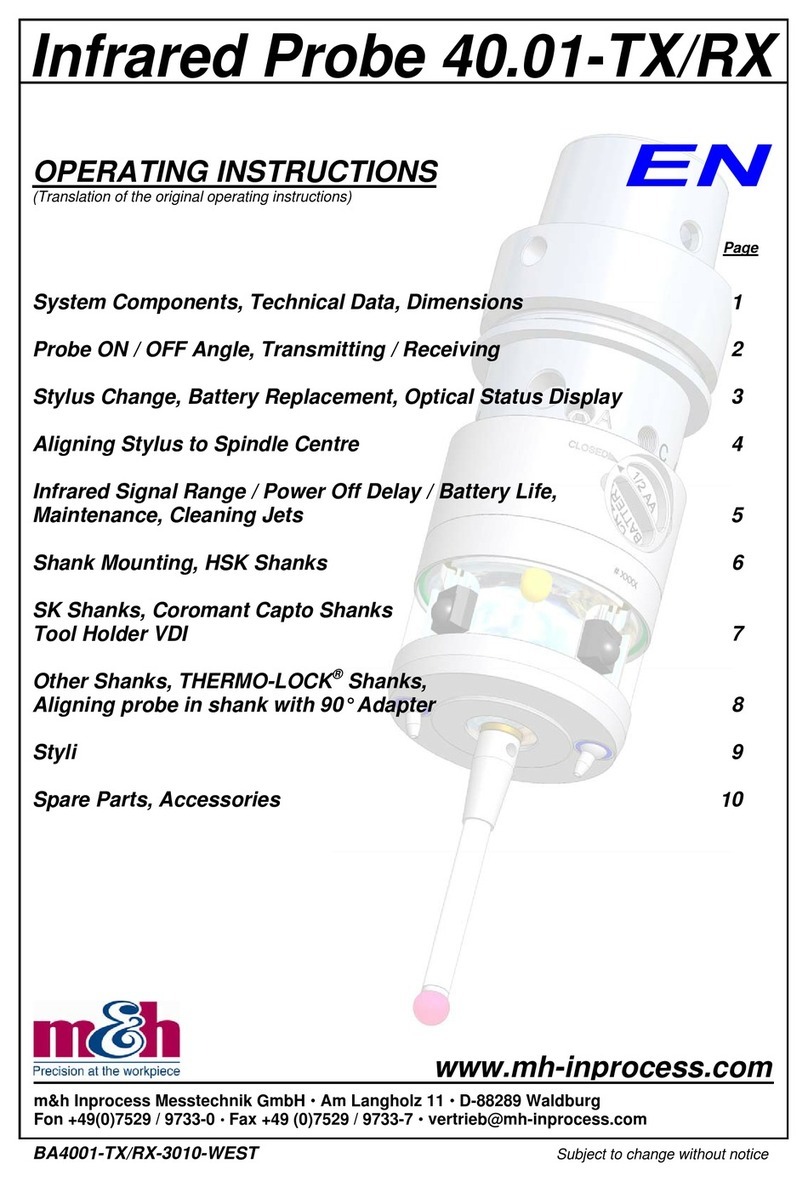
m&h Inprocess
m&h Inprocess 40.01-TX operating instructions
